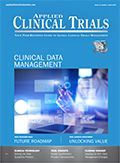Clinical Data Manager: A Roadmap for the Future
Applied Clinical Trials
Breaking down the evolving role of today’s clinical data manager-and its importance as a key cog in the clinical research ecosystem of tomorrow.

Over the past two decades, clinical data managers (CDMs) have seen their responsibilities change dramatically, as the industry shifts toward more complex protocols and elaborate data-collection requirements. “If someone has been in data management for 20 years now, chances are they started working in paper,” says Derek Lawrence, senior clinical data manager with Rho, a contract research organization (CRO). But with the introduction of electronic medical records, CDMs were left to deal with an ever-growing list of new data sources, including eSource, electronic clinical outcome assessment (eCOA), and bring your own device (BYOD), all managed by competing software systems.
Over time, because clinical data management is one of the only roles in the clinical research industry with the word “data” in the title, many of the new advances in data collection and analytics fell to CDMs to figure out, says Lawrence.
As the role expanded to match the breakneck pace of technological development, CDMs suddenly began to wear many hats: computer programmer, clinical operations expert, and biostatistician, all in one.
Making matters worse, “about five years ago, there was a generic flight of data management people into other functional areas,” adds Lawrence. Many gravitated toward project management, and those with technical skills moved into statistical programming.
Because the role has expanded to include so many different responsibilities, many CDMs today feel overworked and under-resourced. Over time, “our tasks have increased … we are much busier than we were before,” says Michael Goedde, chair of the nonprofit Society for Clinical Data Management (SCDM) Board of Trustees and VP, global data operations, PRA Health Sciences.
“It’s no surprise today that what we used to do 20 years ago doesn’t work any more,” adds Patrick Nadolny, SCDM innovation committee chair and associate VP and global head, clinical data management and programming, Allergan.
Against this backdrop, and with the knowledge that more changes are on the horizon, SCDM leadership has embarked on a series of white papers and other educational initiatives to serve as a roadmap for the future of the CDM’s role within the clinical research ecosystem.
The science shift
Though their work is still unfolding, one of the key themes that has emerged is the importance of emphasizing the data science part of a CDM’s role. In the first of three reflection papers, SCDM proposed a new name-clinical data scientist-meant to encompass the growing importance of data mining and extracting value from data and big data, particularly as the field continues to experiment with new technologies like artificial intelligence (AI) and blockchain.
But even as clinical data science and programming skills grow in importance, the clinical operations piece of a CDM’s role is still a crucial one. That is especially evident as trial designs continue to evolve to include decentralized procedures, synthetic arms, and adaptive trial designs.
Because of their “hybrid” skills, CDMs are indispensable players at any research organization, says Lawrence. But with so many responsibilities to juggle, the future of this single, solidified role is precarious.
When asked to define the role of “clinical data manager” as it stands today, Goedde explains that “even though it appears to be a simple question, the answer is quite complex, as it encompasses walking the very fine line of the fundamental (old school) CDM mindset of data integrity as the highest maxim on the one hand, and the exponentially increasing landscape of technology and its potential opportunity on the other hand.” Goedde went on to note that a new SCDM initiative is working to provide more definition to the role of CDM and its transition to clinical data science, to help answer this difficult question.
The simplest way might be to think of CDMs as “guardians of the data,” says Linda King, immediate past chair of SCDM. Nadolny echoed that sentiment, pointing out that “a clinical data manager is responsible for the lifecycle of the data-from collection to the analysis in support of regulatory submission.”
Beyond that critical stewardship, responsibilities vary by organization. But the CDM role is difficult to pin down because it touches almost all aspects of the clinical research enterprise-and it’s constantly evolving.
“In theory, you can have five or more specialists doing all the different areas a clinical data manager would cover,” says Goedde. “But from an operational point of view, that would cause a lot of headaches.”
Today, he adds, the role is “quite fragmented,” but it’s moving toward a place in which CDMs are expected to proactively manage the risk associated with complex data flows and a decentralized trial environment while ensuring data is credible and reliable.
““We are at a tipping point,” says King. “We’ve been observing the trends very closely over the last few years, and looking at opportunities for [SCDM] to define and shape the future.”
“Everybody is scratching their heads on how we are going to cope with the complexity and the speed of change,” adds Nadolny. “What we need to do is define a very clear roadmap of where we are going.”
The recent SCDM reflection paper on the topic, published in June 2019, is called The Evolution of Clinical Data Management to Clinical Data Science (available at https://scdm.org/white-paper/). Nadolny, its lead author, says forthcoming reflection papers will break down exactly how industry leadership can help facilitate this shift from “data management” to “data science.”
“One of the things that we’re doing as a society in leading this change is defining what clinical data science is and what the role of a clinical data scientist is,” says King. “It’s not 100% defined at this point, but what we know is what the new skill sets look like.”
Crucially, a CDM must be “someone who is bringing operation expertise but also scientific insights,” she adds. “They should be using AI/ML (machine learning) to gain insight from the data.”
According to Nadolny, such tools, along with robotic process automation, could eventually ease the heavy load felt by CDMs, who have struggled to manage dozens of new streams of data, from patient-reported outcomes to wearable sensors to mobile apps.
“I don’t expect a data manager to be able to look at 16 million data points,” says Nadolny. “You are going to need more advanced analytics, including AI-based analytics, to identify patterns.”
Core competencies
The next generation of clinical data managers will not only be good data scientists, but they will need to understand how to babysit these new tools. That’s because, left unsupervised, AI and other advanced predictive tools might lead untrained managers down the wrong path. Managers will need to understand how to spot bias, and how to back up decision-making criteria to outside auditors. Even with AI/ML expertise, “you still need a data integrity mindset,” says Goedde.
Lawrence, meanwhile, believes the CDMs of the future will need to understand how to stitch together legacy systems. “Where I see data capture going is the by hand-constructed [electronic data capture] systems, and more folks who understand how to leverage the strength of [application programming interfaces],” says Lawrence. But he also adds that the most important part of a CDM’s job is “a strong analytical mindset. It’s not a programming language, it’s not an educational degree-it’s anybody that can look at a project with 35 moving pieces and find novel solutions.”
Current CDMs who possess all these qualities at once are exceedingly rare. In recent years, “they have evolved in their individual organizations out of necessity,” contends Lawrence. “A whole group of disparate people with a pretty diverse skill set just kind of came into being.”
“We have basically created a new functional area within clinical research,” adds Lawrence. “The role that has emerged are the folks that are involved in integrating these systems and working in a variety of programming languages to generate the safety rails for clinical data.” However, he acknowledged, “it doesn’t have a name on it, and it’s scattered.”
“I think we have a big opportunity to rebrand, [but] we do not want a cosmetic title change,” says Nadolny, who believes in the future, “this role will be responsible for managing the flow and quality of data. The role is becoming more scientific, as opposed to just managing the data.”
That’s exactly why Nadolny proposed the term “clinical data scientist,” to encompass this shifting role, although he acknowledges that each organization will likely use different titles to describe the same basic responsibilities.
In the future, “the title is not going to be data manager,” agrees Lawrence. “It would almost be something akin to ‘database engineer,’” he says, encompassing a job that emphasizes clean data capture, risk minimization, and providing an output that is fit-for-purpose.
Part of the current uncertainty may stem from the fact that today’s leadership is still working to let go of an “old school” way of doing things, says Goedde. But the next generation-Millennials and Gen Z-grew up in an environment in which fast-moving, disparate data isn’t necessarily seen as a problem.
Next-gen nurturing
Looking to the future, Goedde believes that, to some extent, it’s about “empowering the next generation of data scientists and managers for whom it will be much more natural to work with all this data.” “Embracing this change is fundamental to me from a leadership perspective,” he adds.
According to King, there are some universities now that have masters in data science programs and they offer clinical research programs. “I think as the profession evolves, we will get an influx of individuals from those programs,” she says. “However, I also think today’s data manager is well positioned to apply their fundamental data management domain knowledge using new tools and techniques as a clinical data scientist.”
Despite the ongoing discussion surrounding the exact “rebranding” of the CDM’s role, industry leaders agree that the role will remain laser-focused on data integrity and data quality, meaning data is managed the right way to ensure it is credible and reliable.
“If you don’t have data integrity, you can’t draw inferences or conclusions,” says King.
Sony Salzman is a freelance journalist who specializes in health and medical innovation. She can be reached at sonysalz@gmail.com.

FDA-Approved Gene Therapy Beqvez Shows Sustained Efficacy, Safety in Long-Term Hemophilia B Trial
April 17th 2025Beqvez (fidanacogene elaparvovec), an FDA-approved one-time gene therapy for hemophilia B, demonstrated sustained factor IX expression, low bleeding rates, and a favorable safety profile over long-term follow-up.
Improving Relationships and Diversifying the Site Selection Process
April 17th 2025In this episode of the Applied Clinical Trials Podcast, Liz Beatty, co-founder and chief strategy officer, Inato, discusses a number of topics around site engagement including community-based sites, the role of technology in improving site/sponsor relationships, how increased operational costs are impacting the industry, and more.
Behind the Buzz: Why Clinical Research Leaders Flock to SCOPE Summit
February 7th 2025In this episode, we meet with Micah Lieberman, Executive Conference Director for SCOPE Summit (Summit for Clinical Ops Executives) at Cambridge Innovation Institute. We will dive deep into the critical role of collaboration within the clinical research ecosystem. How do we bring together diverse stakeholders—sponsors, CROs, clinical trial tech innovators, suppliers, patients, sites, advocacy organizations, investors, and non-profits—to share best practices in trial design, program planning, innovation, and clinical operations? We’ll explore why it’s vital for thought leaders to step beyond their own organizations and learn from others, exchanging ideas that drive advancements in clinical research. Additionally, we’ll discuss the pivotal role of scientific conferences like SCOPE Summit in fostering these essential connections and collaborations, helping shape the future of clinical trials. Join us as we uncover how collective wisdom and cross-industry partnerships are transforming the landscape of clinical research.